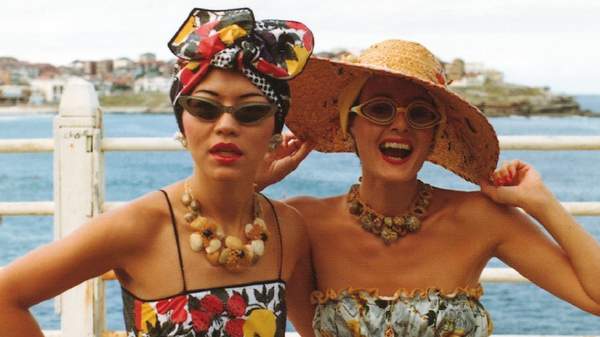Overview
Last month the National Gallery of Victoria launched the first ever major survey of Australian fashion. Featuring over 120 works from more than 90 designers, 200 Years of Australian Fashion not only had us wowed with the scale, diversity and sheer beauty of the threads on display, but also contemplating the thread that runs through each product born of the Australian fashion industry.
It's quite a unique industry to be in — isolated, out of season and catering to a completely different market to the global fashion players. But out of this, a new innovative and creative approach to fashion has been born. It's certainly seen successes, from Collette Dinnigan being the first Australian invited to show at Paris Fashion Week in 1995 to Dion Lee, who last year showed his fifth season at New York Fashion Week.
Is it our position in the global market that defines our aesthetic? We asked local designers Perks and Mini and Pageant as well as the NGV's Curator of Fashion and Textiles Paola De Trocchio to define how they see Australian fashion.
AMANDA CUMMING AND KATE REYNOLDS, PAGEANT
Do you think there is an Australian aesthetic in fashion?
There is a casualness and subtle eclecticism about the way Australian's dress. It's offbeat and relaxed!
Do you think Australia's distance from the rest of the world has influenced our fashion?
As designers, this distance can be challenging but it also gives us the freedom to create our own rules. The fashion industry in Australia is still young and not set in tradition, which we feel creates more flexibility and creativity through design.
Is there a designer or particular time period that defines Australian fashion for you?
We really admire Dion Lee and feel that he has helped to shape the global image of Australian fashion. His designs always push the boundaries and his textile development is impressive!
What would you like to see local designers doing?
As designers we feel it's important to be aware of your surroundings and reflect on current culture. It's really important to be authentic, as originality is key to a strong vision.
SHAUNA TOOHEY, PERKS AND MINI
Do you think there is an Australian aesthetic in fashion?
No. But I do think there is a uniquely Australian attitude to fashion. I think it tends to be more relaxed, it doesn't follow rules and is more forgiving.
Do you think Australia's distance from the rest of the world has influenced our fashion?
Yes, distance and also seasonal difference has had a big effect on Australian fashion. However, as the world be comes more global, seasons drop earlier and climate change affects weather, I think this will have less influence.
Is there a designer or particular time period that defines Australian fashion for you?
Growing up with rave and street culture, the stand outs for me are Galaxy Abyss and Funk Essentials both by Sara Thorn and Bruce Slorach.
What would you like to see local designers doing?
My favourite designers are ones where you can see their unique signature in there clothes. Too often you see garments where the neck label could be lots of different brands/designers and it would be believable. I would love to see designers finding their own unique vision and expressing that in their clothing so well that each piece is recognisably theirs.
PAOLA DI TROCCHIO, CURATOR, FASHION AND TEXTILES AT THE NGV
Do you think there is an Australian aesthetic in fashion?
What Australian designers have in common is a sense of adventure, resilience, and courage. This can translate to bold, sophisticated and innovative design with a streak of rebellion.
Do you think Australia's distance from the rest of the world has influenced our fashion?
I think it has caused our designers to be incredibly innovative with their business systems and structures. For example, recognising that they could not compete with and did not even desire to fit into established fashion conventions from the context of Australia, DI$COUNT UNIVER$E launched their brand online through their blog, redefining the rules of what a fashion label could be. MaterialByProduct's engagement with the concept of luxury and artisanal hand production can be seen as suited to systems of production in Australia, where the majority of the businesses are small-scale enterprises with low-production capacity.
Is there a designer or particular time period that defines Australian fashion for you?
Australian fashion is evolving as we are as a nation. The earliest dress in the exhibition is from c.1805. Its raised waist and slim skirt are known as the empire line. Its Indian muslin fabric acknowledges the immediate network of trade between India, Australia and Britain. It situates the origins of Australian fashion within the broad context of Britain's aspirations towards the Empire and within a network of international trade. Since then Australian designers have continued a dialogue with the wider world that has echoed politics, trends, social movements, trade and identity. I think what is fascinating about Australian fashion is how Australian designers look inwards to find within them their unique voice, whilst looking out and engaging with the wider world.
What would you like to see local designers doing?
Thriving. I think they are doing incredibly well and I look forward to seeing them reach greater heights.
200 Years of Australian Fashion is now showing at NGV Australia until July 31. For more information, visit ngv.vic.gov.au.
Top image: Linda Jackson and Jenny Kee wearing Linda Jackson's Tutti Frutti dress, 1975. Photograph by Ann Noon.
